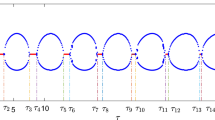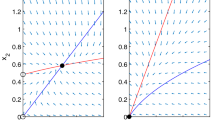Abstract
The population-dispersal dynamics for predator–prey interactions and two competing species in a two patch environment are studied. It is assumed that both species (i.e., either predators and their prey, or the two competing species) are mobile and their dispersal between patches is directed to the higher fitness patch. It is proved that such dispersal, irrespectively of its speed, cannot destabilize a locally stable predator–prey population equilibrium that corresponds to no movement at all. In the case of two competing species, dispersal can destabilize population equilibrium. Conditions are given when this cannot happen, including the case of identical patches.
Similar content being viewed by others
References
Abrams PA (2005) ‘Adaptive Dynamics’ vs. ‘adaptive dynamics’. J Evol Biol 18: 1162–1165
Abrams PA (2007) Habitat choice in predator-prey systems: spatial instability due to interacting adaptive movements. Am Nat 169: 581–594
Abrams PA (2010) Implications of flexible foraging for interspecific interactions: lessons from simple models. Funct Ecol 24: 7–17
Abrams PA, Cressman R, Křivan V (2007) The role of behavioral dynamics in determining the patch distributions of interacting species. Am Nat 169: 505–518
Ahlering MA, Faaborg J (2009) Avian habitat management meets conspecific attraction: if you build it, will they come?. Auk 123: 301–312
Allen L (2007) An introduction to mathematical biology. Prentice Hall, Upper Saddle River, p 07458
Amarasekare P (1998) Interactions between local dynamics and dispersal: insights from single species models. Theor Popul Biol 53: 44–59
Bascompte J, Solé RV (1995) Spatially induced bifurcations in single-species population dynamics. J Anim Ecol 63: 256–265
Bolker B, Holyoak M, Křivan V, Rowe L, Schmitz OJ (2003) Connecting theoretical and empirical studies of trait-mediated interactions. Ecology 84: 1101–1114
Briggs CJ, Hoopes MF (2004) Stabilizing effects in spatial parasitoid-host and predator-prey models: a review. Theor Popul Biol 65: 299–315
Cantrell RS, Cosner C, DeAngelis DL, Padron V (2007) The ideal free distribution as an evolutionarily stable strategy. J Biol Dyn 1: 249–271
Comins H, Hamilton W, May R (1980) Evolutionarily stable dispersal strategies. J Theor Biol 82: 205–230
Cosner C (2008) Reaction-diffusion equations and ecological modeling. In: Freedman A (ed) Tutorials in mathematical biosciences IV. Lecture notes in mathematics, vol 1922. Springer, Berlin, pp 77–116
Cressman R, Křivan V (2006) Migration dynamics for the ideal free distribution. Am Nat 168: 384–397
Cressman R, Vickers GT (1997) Spatial and density effects in evolutionary game theory. J Theor Biol 184: 359–369
Cressman R, Křivan V, Garay J (2004) Ideal free distributions, evolutionary games, and population dynamics in multiple-species environments. Am Nat 164: 473–489
Dercole F, Rinaldi S (2008) Analysis of evolutionary processes. The adaptive dynamics approach and its applications. Princeton University Press, Princeton
Dieckmann U, O’Hara B, Weisser W (1999) The evolutionary ecology of dispersal. Trends Ecol Evol 14: 88–90
Diffendorfer JE (1998) Testing models of source-sink dynamics and balanced dispersal. Oikos 81: 417–433
Donahue MJ, Holyoak M, Feng C (2003) Patterns of dispersal and dynamics among habitat patches varying in quality. Am Nat 162: 302–317
Ferriere R, Belthoff JR, Olivieri I, Krackow S (2000) Evolving dispersal: where to go next?. Trends Ecol Evol 15: 5–7
Folmer E, Olff H, Piersma T (2010) How well do food distributions predict spatial distributions of shorebirds with different degrees of self-organization?. J Anim Ecol 79: 747–756
Fretwell DS, Lucas HL (1969) On territorial behavior and other factors influencing habitat distribution in birds. Acta Biotheoretica 19: 16–32
Gadgil M (1971) Dispersal: population consequences and evolution. Ecology 52: 253–261
Gause GF (1934) The struggle for existence. Williams and Wilkins, Baltimore
Geritz SAH, Kisdi E, Meszéna G, Metz JAJ (1998) Evolutionarily singular strategies and the adaptive growth and branching of the evolutionary tree. Evol Ecol 12: 35–57
Greenslade TB (1993) All about Lissajous figures. Phys Teacher 31: 364–370
Hamilton WD, May RM (1977) Dispersal in stable habitats. Nature 269(5629): 578–581
Hanski I (1999) Metapopulation ecology. Oxford University Press, New York
Hanski, IA, Gilpin, ME (eds) (1997) Metapopulation biology: ecology, genetics, and evolution. Academic Press, San Diego
Hassell MP, Comins HN, May RM (1991) Spatial structure and chaos in insect population dynamics. Nature 353: 255–258
Hassell MP, Miramontes O, Rohani P, May RM (1995) Appropriate formulations for dispersal in spatially structured models: comments on Bascompte & Solé. J Anim Ecol 64: 662–664
Hastings A (1983) Can spatial variation alone lead to selection for dispersal?. Theor Popul Biol 24: 244–251
Hofbauer J, Sigmund K (1988) The theory of evolution and dynamical systems. Cambridge University Press, Cambridge
Hofbauer J, Sigmund K (1998) Evolutionary games and population dynamics. Cambridge University Press, Cambridge
Holt RD (1984) Spatial heterogeneity, indirect interactions, and the coexistence of prey species. Am Nat 124: 377–406
Holt RD (1985) Population dynamics in two-patch environments: some anomalous consequences of an optimal habitat distribution. Theor Popul Biol 28: 181–208
Holt RD, Barfield M (2001) On the relationship between the ideal-free distribution and the evolution of dispersal. In: Danchin JCE, Dhondt A, Nichols J (eds) Dispersal. Oxford University Press, New York, pp 83–95
Holt RD, McPeek MA (1996) Chaotic population dynamics favors the evolution of dispersal. Am Nat 148: 709–718
Huang Y, Diekmann O (2003) Interspecific influence on mobility and Turing instability. Bull Math Biol 65: 143–156
Jansen VAA, Lloyd AL (2000) Local stability analysis of spatially homogeneous solutions of multi-patch systems. J Math Biol 41: 232–252
Kennedy M, Gray RD (1993) Can ecological theory predict the distribution of foraging animals? A critical analysis of experiments on the ideal free distribution. Oikos 68: 158–166
Křivan V (2008) Prey-predator models. In: Jorgensen SE, Fath BD (eds) Encyclopedia of ecology, vol 4. Elsevier, Oxford, pp 2929–2940
Křivan V, Sirot E (2002) Habitat selection by two competing species in a two-habitat environment. Am Nat 160: 214–234
Křivan V, Cressman R, Schneider S (2008) The ideal free distribution: a review and synthesis of the game-theoretic perspective. Theor Popul Biol 73: 403–425
Kuznetsov YA (1995) Elements of applied bifurcation theory. Applied mathematical sciences, no 112. Springer, New York
Levin SA (1974) Dispersion and population interactions. Am Nat 108: 207–228
Levin SA (1992) The problem of pattern and scale in ecology. Ecology 73: 1943–1967
Losos JB, Schoener TW, Langerhans RB, Spiller DA (2006) Rapid temporal reversal in predator-driven natural selection. Science 314: 1111
McPeek MA, Holt RD (1992) The evolution of dispersal in spatially and temporally varying environments. Am Nat 140: 1010–1027
Morris DW (1999) Has the ghost of competition passed?. Evol Ecol Res 1: 3–20
Murdoch WW, Briggs CJ, Nisbet RM (2003) Consumer-resource dynamics. Princeton University Press, Princeton
Padrón V, Trevisan MC (2006) Environmentally induced dispersal under heterogeneous logistic growth. Math Biosci 199: 160–174
Relyea RA, Auld JR (2004) Having the guts to compete: how intestinal plasticity explains costs of inducible defences. Ecol Lett 7: 869–875
Rohani P, Ruxton GD (1999a) Diffusion-induced instabilities in host-parasitoid metapopulations. Theor Popul Biol 55: 23–36
Rohani P, Ruxton GD (1999b) Dispersal and stability in metapopulations. IMA J Math Appl Med Biol 16: 297–306
Rosenzweig ML, MacArthur RH (1963) Graphical representation and stability conditions of predator-prey interactions. Am Nat 97: 209–223
Ruxton GD (1996) Density-dependent migration and stability in a system of linked populations. Bull Math Biol 58: 643–660
Svirezhev YM, Logofet DO (1983) Stability of biological communites. Mir Publishers, Moscow
Takeuchi Y (1996) Global dynamical properties of Lotka-Volterra systems. World Scientific, Singapore
Taylor PD, Jonker LB (1978) Evolutionary stable strategies and game dynamics. Math Biosci 40: 145–156
Tilman D, Kareiva P (1997) Spatial ecology: the role of space in population dynamics and interspecific interactions. Monographs in population biology, no 30. Princeton University Press, Princeton
Turing AM (1952) The chemical basis of morphogenesis. Phil Trans R Soc Lond B 237: 37–72
Vincent TL, Brown JS (2005) Evolutionary game theory, natural selection, and Darwinian dynamics. Cambridge University Press, Cambridge
Werner EE, Peacor SD (2003) A review of trait-mediated indirect interactions in ecological communities. Ecology 84: 1083–1100
Wikelski M, Thom C (2000) Marine iguanas shrink to survive El Nino—changes in bone metabolism enable these adult lizards to reversibly alter their length. Nature 403: 37–38
Yalden DW (2000) Shrinking shrews. Nature 403: 826
Author information
Authors and Affiliations
Corresponding author
Rights and permissions
About this article
Cite this article
Cressman, R., Křivan, V. Two-patch population models with adaptive dispersal: the effects of varying dispersal speeds. J. Math. Biol. 67, 329–358 (2013). https://doi.org/10.1007/s00285-012-0548-3
Received:
Revised:
Published:
Issue Date:
DOI: https://doi.org/10.1007/s00285-012-0548-3
Keywords
- Competition
- Dispersal
- Evolution
- Habitat selection
- Ideal free distribution
- Predator
- Prey
- Population dynamics




